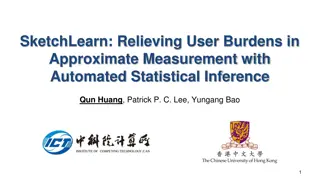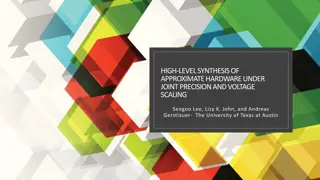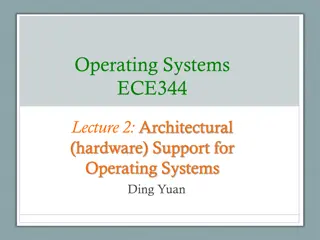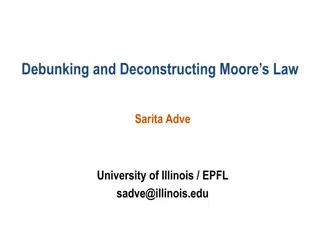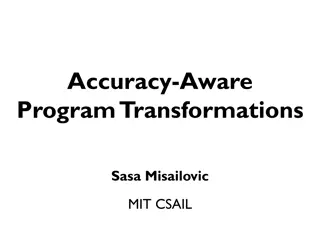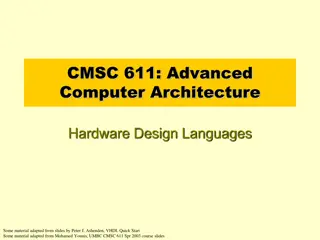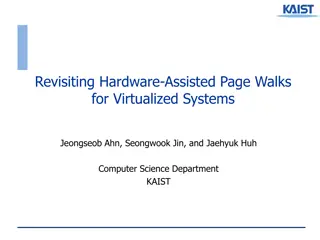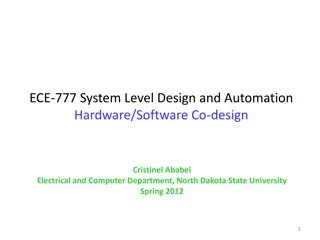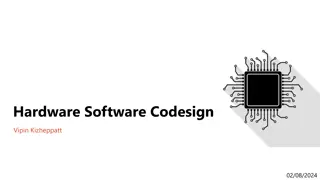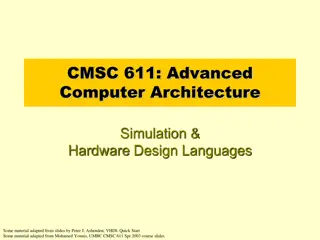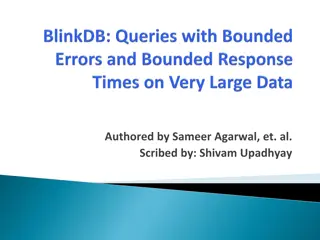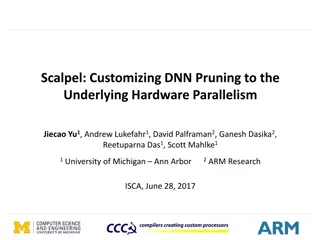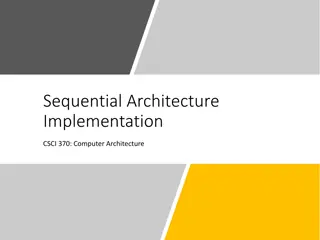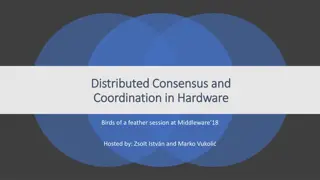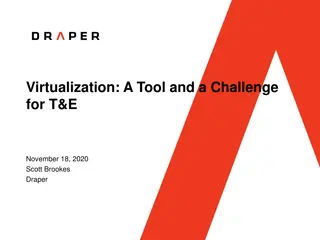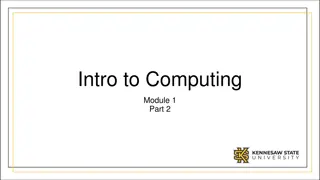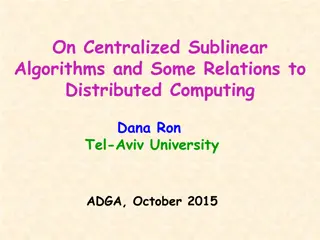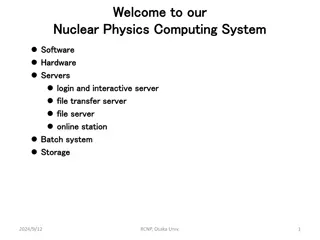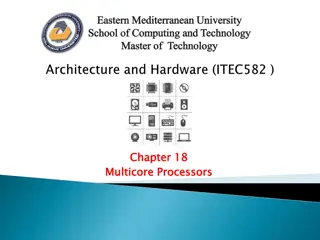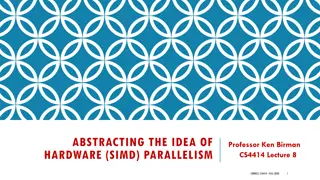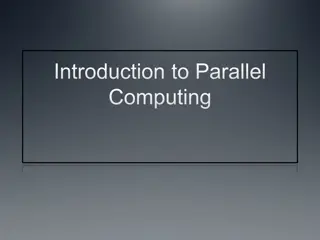Approximate Computing in Hardware Design: A Comprehensive Overview
Explore the groundbreaking concepts of approximate computing in hardware design, which involves embracing errors to enhance resource efficiency and performance. Delve into topics such as avoiding worst-case design, criteria for approximate HDL, safety in hardware, and relaxing accuracy requirements for specific modules. Discover how these innovations are revolutionizing the field of hardware design.
- Hardware Design
- Approximate Computing
- Resource Efficiency
- Performance Enhancement
- Innovative Concepts
Download Presentation

Please find below an Image/Link to download the presentation.
The content on the website is provided AS IS for your information and personal use only. It may not be sold, licensed, or shared on other websites without obtaining consent from the author. Download presentation by click this link. If you encounter any issues during the download, it is possible that the publisher has removed the file from their server.
E N D
Presentation Transcript
Axilog: Language Support for Approximate Hardware Design Amir Yazdanbakhsh Divya Mahajan Bradley Thwaites Jongse Park Anandhavel Nagendrakumar Sindhuja Sethuraman Kartik Ramkrishnan Nishanthi Ravindran Rudra Jariwala Abbas Rahimi Hadi Esmaeilzadeh Kia Bazargan Georgia Institute of Technology University of Minnesota UC San Diego Georgia Institute of Technology Alternative Computing Technologies (ACT) Lab DATE 2015
Approximate computing Embracing error Relax the abstraction of near-perfect accuracy in general-purpose computing/communication/storage Allow errors to happen during computation/communication/storage Improve resource utilization efficiency Energy, bandwidth, capacity, Improve performance Build acceptable systems from intentionally-made unreliable software and hardware components Avoid overkill and worst-case design 2
Avoiding Worst-Case Design Approximate Computing Generality Application Performance Programming Language Efficiency Compiler Architecutre Microarchitecture Circuit Cost Cost Precision Reliability Determinism Physical Device 3
Criteria Goals Design the first HDL for 1)Approximate Hw Design 2)Approximate Hw Reuse 3)Approximate Synthesis Approximate HDL shall be 1) High-level 2) Automated 3) Backward compatible 4
Safety in Hardware Approximate Precise Precise Datapath Controller Clock 5
Axilog Annotations Design Annotations restrict relax (restrict_global) (relax_local) Reuse Annotations critical bridge approximate 6
Relaxing Accuracy Requirements module ripple_carry_adder(a, b, c_in, c_out, s) full_adder f0(a[0], b[0], c_in, w0, s[0]) full_adder f1(a[1], b[1], w0, c_out, s[1]) relax (s); 8
Relaxing Accuracy Requirements module ripple_carry_adder(a, b, c_in, c_out, s) full_adder f0(a[0], b[0], c_in, w0, s[0]) full_adder f1(a[1], b[1], w0, c_out, s[1]) relax (s); 9
Scoping Approximation (relax_local) module full_adder (a, b, c_in, c_out, s) relax_local (s); full_adder f0 ( ) full_adder f1( ) relax (s[0]); 10
Scoping Approximation (relax_local) module full_adder (a, b, c_in, c_out, s) relax_local (s); full_adder f0 ( ) full_adder f1( ) relax (s[0]); 11
Restricting Approximation Globally module full_adder(a, b, c_in, c_out, s); approximateoutput s; relax (s); endmodule restrict_global(s[31:0]); 15
Restricting Approximation Globally module full_adder(a, b, c_in, c_out, s); approximateoutput s; relax (s); endmodule restrict_global(s[31:0]); 16
Critical Inputs criticalinput reset; criticalinput clock; reset Output Logic State Register Next State Logic clock 19
Bridging Approximate Wires to Critical Inputs and a1(s, a0, a1); relax (s); bridge (s); multiplexer m0(s, a0, a1, out); 20
Bridging Approximate Wires to Critical Inputs and a1(s, a0, a1); relax (s); bridge (s); multiplexer m0(s, a0, a1, out); 21
Baseline Synthesis Flow Highest frequency with minimum power and area 22
Relaxability Inference Analysis Circuit under analysis with Axilog annotations Identify the wires which are driving unannotated wires or annotated with restrict within the module under analysis Identify the relaxed outputs of the instantiated submodules Marks any wire that affects a globally restricted wire as precise Safe to approximate gates 23
Approximate Synthesis Flow Axilog Code Axilog Compiler Safe to Approximate Gates 24
Measurements Tools for Synthesis and Energy Analysis Synopsys Design Compiler Synopsys Primetime Timing Simulation with SDF back annotations Cadence NC-Verilog Standard Cell Library TSMC 45-nm multi-Vt Slowest PVT corner (SS, 0.81V, 0C) for baseline results 25
Benchmarks Arithmetic Computation, Signal Processing, Robotics, Machine Learning, Image Processing # Annotations Design: 6 Reuse: 5 FIR # lines: 113 Signal Processing # Annotations Design: 6 Reuse: 3 # Annotations Design: 1 Reuse: 1 Sobel Brent-Kung # lines: 352 Arithmetic Computation # lines: 143 Image Processing # Annotations Design: 1 Reuse: 1 # Annotations Design: 7 Reuse: 3 Kogge-Stone # lines: 353 Arithmetic Computation K-means # lines: 10,985 Machine Learning # Annotations Design: 5 Reuse: 3 # Annotations Design: 5 Reuse: 4 Wallace Tree # lines: 13,928 Arithmetic Computation ForwardK # lines: 18,282 Robotics # Annotations Design: 4 Reuse: 3 # Annotations Design: 8 Reuse: 4 Neural Network # lines: 21,053 Machine Learning InverseK # lines: 22,407 Robotics 26
Energy Reduction 2.0 Error 10% Error 5% 1.9 1.8 Energy Reduction 1.7 1.6 1.5 1.4 1.3 1.2 1.1 1.0 27
Area Reduction 2.6 Error 10% Error 5% 2.4 2.2 Area Reduction 2.0 1.8 1.6 1.4 1.2 1.0 28
Output Quality Degradation in Sobel 0% Quality Loss 5% Quality Loss 10% Quality Loss 10% Quality loss is nearly indiscernible to the eye Yet provides 57% energy savings 29
Energy Reduction for Different PVT Corners 100% (SS, 0.81V, 125 C) (SS, 0.81V, 0 C) 90% 80% Energy Reduction 70% 60% 50% 40% 30% 20% 10% 0% 30
First HDL for Approximation Design Reuse Automation High-level Backward-compatibility Axilog Area Energy Savings Code Reduction Annotations 1.9 54% 2-12 http://www.act-lab.org/artifacts/axilog 31




